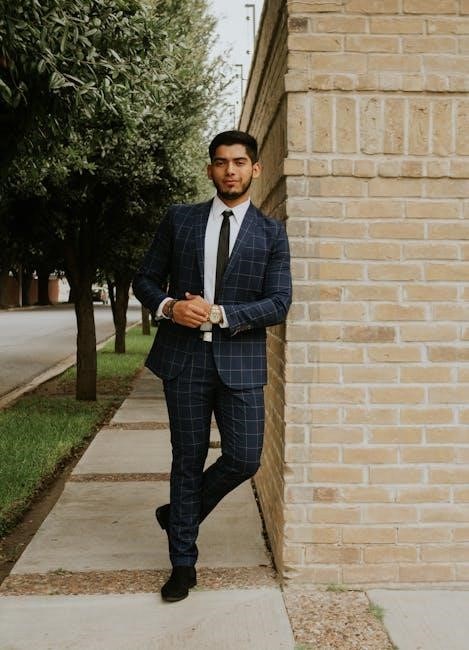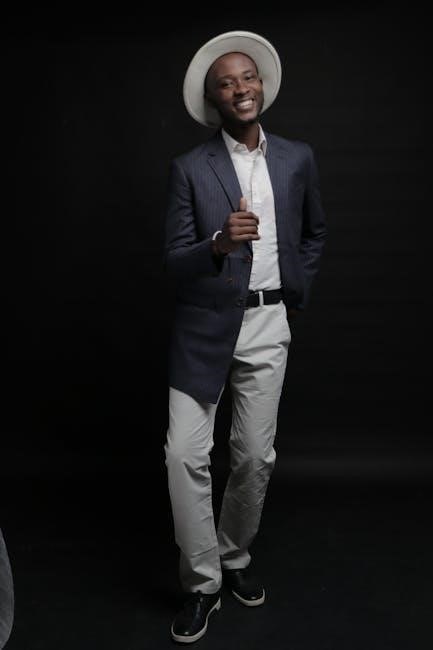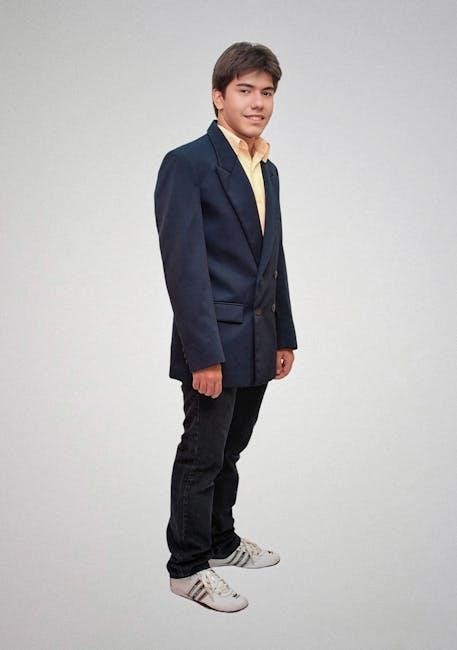A well-fitted suit jacket is essential for a polished look. This guide explores the importance of jacket length, styles, and how to achieve a perfect, proportional fit for any body type or occasion.
Importance of Proper Jacket Length
Proper jacket length ensures a balanced, polished appearance, enhancing overall proportion. It impacts how other elements, like sleeves and pants, fit and look. A well-fitted jacket creates a streamlined silhouette, making the wearer appear taller or more proportional. Ill-fitting jackets can detract from the suit’s elegance, making it look cheap or unprofessional. Correct length is key to confidence and style, ensuring the suit looks tailored to perfection. It’s a foundational element that elevates the entire outfit’s aesthetic.
Overview of Suit Jacket Styles
Suit jackets come in various styles, each with distinct features. Single-breasted jackets are classic and versatile, often with two or three buttons. Double-breasted styles offer a formal look with multiple buttons. Slim-fit jackets are tailored closely to the body, while oversized styles provide a relaxed fit. Each style influences jacket length, balancing proportions for different body types and preferences. Understanding these styles helps in selecting the ideal jacket that aligns with personal taste and occasion, ensuring a flattering and polished appearance.

Factors Determining Jacket Length
Jacket length is influenced by body type, personal style, and functional needs. Proper proportions ensure a balanced look, enhancing overall comfort and aesthetic appeal.
Body Type and Proportions
Your body type significantly impacts the ideal jacket length. For taller men, a longer jacket balances proportions, while shorter individuals benefit from shorter styles to avoid overwhelming their frame. Slim builds look best with tailored fits, ensuring the jacket isn’t too boxy. Conversely, broader shoulders may require a slightly longer jacket to create balance. Proper fit ensures comfort and a polished appearance, making understanding your body type crucial for selecting the right jacket length.
Personal Style and Preference
Personal style plays a key role in choosing jacket length. Modern trends lean toward slim-fit styles with shorter lengths, while classic suits often feature longer jackets. Your lifestyle and preferences should guide this decision. For instance, a formal event may call for a traditional fit, whereas a casual setting might suit a more contemporary, shorter jacket. Ultimately, the jacket should reflect your personality and the occasion, ensuring both comfort and confidence in your appearance. Balancing style with fit is essential for a flattering look.
Measuring for the Perfect Fit
Accurate measurements ensure a tailored look. Stand upright, measure chest size, shoulder width, and sleeve length. Jacket length should hit just below the hip for balance and proportion.
How to Measure Yourself Accurately
Stand upright and use a flexible tape measure. For chest size, wrap the tape around the broadest part of your chest, keeping it level and parallel to the floor. Jacket length should be measured from the base of the neck to the desired jacket hem, typically just below the hip. Sleeve length is measured from the center back of the neck, over the shoulder, and down to the wrist. Ensure the jacket is buttoned for accurate chest measurements. Keep the tape snug but not tight to avoid distortion. This method ensures a precise fit for your suit jacket, aligning with your body proportions and style preferences. Proper alignment and posture are key to achieving accurate results. Always double-check your measurements for consistency and reliability. These steps will help you determine the ideal jacket length and fit for your body type and personal style. Regularly updating your measurements ensures your suits always look their best. By following these guidelines, you can confidently measure yourself for a tailored fit. This process is essential for both off-the-rack and custom-made suits, ensuring comfort and a polished appearance. Accurate measurements are the foundation of a well-fitted suit jacket, making the difference between a good and a great look.
Professional Measurement Techniques
Professional tailors use precise methods to ensure accurate measurements. They measure chest size by wrapping a flexible tape measure around the broadest part of the chest, ensuring it’s level and parallel to the floor. Shoulder slope and jacket length are assessed to maintain proportion. Sleeve length is measured from the center back of the neck to the wrist bone. Professionals also consider posture and body alignment to ensure a flattering fit. This expertise guarantees a tailored look, making professional measurements indispensable for achieving the perfect jacket fit. Regular updates and precise tools ensure accuracy. Tailors may also adjust measurements based on style preferences. Their techniques account for every detail, from chest size to sleeve length, ensuring a polished appearance. Professional measurements are crucial for both custom and off-the-rack suits. They provide a foundation for a well-fitted jacket, enhancing comfort and style. By leveraging their expertise, tailors deliver results that align with individual body types and fashion goals. This ensures a seamless fit tailored to personal preferences. Professional measurement techniques are the key to a perfectly fitted suit jacket. They combine precision with style expertise. The result is a garment that flatters and performs exceptionally. Professional tailors understand the nuances of fit and proportion. Their techniques ensure every measurement is accurate and purposeful. This level of detail is unmatched by self-measurement methods. Professional tailors bring years of experience to the process. Their techniques guarantee a perfect fit every time.
Understanding Jacket Fit
A well-fitted jacket enhances your appearance and confidence. It should sit naturally on the shoulders, close properly, and balance proportionally with your pants and body type for a polished look.
Ideal Fit Characteristics
An ideally fitted suit jacket should sit seamlessly on the shoulders, aligning with the natural slope without puckering or sagging. The front should close comfortably, neither too tight nor too loose, allowing a flat appearance. Sleeves should extend to showcase about ¼ inch of shirt cuff, ensuring proportionality. The jacket length should complement the wearer’s height and pants, creating a balanced silhouette. A well-fitted jacket drapes naturally, enhancing posture and confidence, with no restriction or excess fabric, ensuring a polished, tailored look that flatters the body.
Common Fit Mistakes to Avoid
Common mistakes include jackets that are too long or too short, disrupting proportion. Ensure sleeves don’t cover too much shirt cuff—about ¼ inch is ideal. Jackets that are overly tight restrict movement, while those too loose look sloppy. Shoulders must align with natural body contours; misalignment can ruin the fit. Avoid excessive fabric pooling at the chest, as it should lie flat. Addressing these issues ensures a polished, confident appearance and a tailored look that enhances overall style.

Style Considerations
Suit jacket length impacts overall style. Single-breasted jackets often feature shorter lengths for a modern look, while double-breasted styles may extend slightly longer for a classic aesthetic. Current trends emphasize streamlined fits, balancing proportion with personal taste. Understanding these considerations ensures a stylish, contemporary appearance tailored to individual preferences and fashion-forward sensibilities.
Single vs. Double-Breasted Jackets
Single-breasted jackets are sleek and modern, with a shorter length, while double-breasted styles offer a classic, slightly longer silhouette. Single-breasted suits are versatile and suit most body types, whereas double-breasted jackets can enhance broader shoulders. The choice between the two often depends on personal style and current fashion trends. Both styles emphasize proper fit, ensuring the jacket length complements the wearer’s proportions and creates a balanced, polished appearance. Understanding these differences helps in selecting a jacket that aligns with individual preferences and aesthetic goals.
Current Fashion Trends in Jacket Length
Current fashion trends favor tailored, contemporary jacket lengths that enhance a streamlined silhouette. Slim-fit jackets with slightly shorter lengths are popular, offering a modern aesthetic while maintaining proportion. Double-breasted styles often feature longer, structured designs, blending classic elegance with current trends. The key is balancing jacket length with body type and personal style. Trends emphasize clean lines and precise fit, ensuring the jacket complements the wearer’s physique. Staying informed about these styles helps in selecting a jacket that aligns with modern fashion while ensuring timeless appeal and comfort.

Jacket Length and Proportions
Jacket length must align with sleeve proportions, ensuring a balanced look. The hem should graze the pant break, creating harmony between the jacket and trousers.
Relation to Sleeve Length
The jacket’s sleeve length is closely tied to its overall length. A proper fit shows about 1/4 inch of shirt sleeve, ensuring the cuffs align proportionally. This balance creates a streamlined appearance, preventing the jacket from looking too long or short. The sleeve length should complement the jacket’s hem, maintaining harmony with the body’s proportions. Proper alignment ensures the suit looks tailored, enhancing both style and functionality; This balance is key to achieving a polished, professional look in any setting.
Balance with Pants and Overall Suit
A suit jacket’s length should harmonize with the pants and overall suit proportions. The jacket’s hem should align with the thumb’s base when arms are straight, ensuring balance. Pants break slightly over the shoes, creating a cohesive look. Proper proportions ensure the suit appears tailored, avoiding a boxy or overly slim silhouette. This balance enhances the wearer’s posture and style, making the suit look polished and well-fitted. Achieving this harmony is crucial for a professional and put-together appearance in both formal and casual settings.
Maintenance and Alterations
Regular care and timely alterations ensure your suit jacket retains its fit and appearance. Proper cleaning, storage, and adjustments maintain its quality and extend its lifespan effectively.
When to Alter Jacket Length
Alterations are necessary if the jacket length no longer complements your proportions or style. Consider shortening or lengthening the jacket if it fails to cover the hips or aligns improperly with the sleeves. Changes in body weight, trends, or personal preferences may also warrant modifications. Regular wear and tear, such as frayed hems or uneven edges, should be addressed promptly to maintain a polished appearance. Tailoring ensures the jacket remains flattering and functional, preserving its quality and fit over time.
Care Tips to Maintain Fit
To preserve your suit jacket’s fit, avoid excessive dry cleaning and opt for spot cleaning with a damp cloth when needed. Store the jacket on a padded hanger to maintain its shape and prevent stretching. Allow wrinkles to settle naturally or use steam sparingly. Avoid folding the jacket for extended periods, as this can cause creases and misshapen shoulders. Regularly inspect and repair loose threads or buttons to uphold the jacket’s appearance and ensure a sharp, tailored look over time;

Jacket Length for Different Occasions
Jacket length varies by occasion: formal events demand traditional longer styles, while business settings favor classic or modern fits, and casual events may suit shorter, trendier options.
Formal Events
For formal events like weddings or black-tie affairs, a longer jacket length is traditional, ensuring a balanced, elegant silhouette. The jacket should graze the thigh for a classic look, with a subtle break where it meets the pants. Peak lapel or shawl collar styles are popular choices, offering sophistication. Current trends lean toward slightly shorter jackets, but the timeless two-button or double-breasted remains a staple. Ensuring the jacket fits seamlessly with trousers creates an impeccable, polished appearance for formal occasions.
Casual and Business Settings
In casual and business settings, suit jacket length should strike a balance between comfort and professionalism. A slightly shorter jacket, often seen in slim-fit styles, is versatile for everyday wear. It pairs well with tailored trousers or chinos for a sharp, modern look. Ensure the jacket shows about 1/4 inch of shirt sleeve for a polished appearance. For casual settings, layering with an open-collar shirt or a sweater adds a relaxed yet stylish touch, making the outfit adaptable to various environments while maintaining sophistication.

Frequently Asked Questions
Common queries include determining ideal jacket length, proper sleeve visibility, and how body type influences fit. These questions ensure a tailored, polished appearance for any occasion.
Common Queries About Jacket Length
Questions often revolve around ideal sleeve length, ensuring cuffs align with shirt cuffs, and jacket hem placement just below the hip for balance. Body type and occasion also influence length choices, with shorter jackets suiting casual settings and longer styles for formal events. Proper fit ensures a polished look, addressing common concerns about proportion and style.
Solving Specific Fit Issues
Common fit issues include sleeves too long or short, jackets too tight or loose, and misaligned proportions. Tailoring adjustments, like shortening sleeves or letting out seams, can resolve these problems. Ensuring the jacket hem rests slightly below the hip and aligning the shoulder fit with body type enhances comfort and aesthetics. Proper fit ensures balance, addressing specific concerns for a polished, tailored look.
A well-fitted suit jacket enhances confidence and elegance. Understanding jacket length and proportions ensures a polished, tailored look, making it a worthwhile investment for any wardrobe.

Final Thoughts on Jacket Length
A suit jacket’s length is a cornerstone of its fit and style. Properly balanced, it complements the body, ensuring a harmonious silhouette. Whether for formal events or casual settings, investing time in selecting the right length ensures a sharp, put-together appearance. Remember, the jacket should align with the natural proportions of your torso, creating a seamless line from shoulder to hip. This attention to detail elevates your look, making every occasion effortlessly stylish.
Encouragement for Perfect Fit
Achieving the perfect suit jacket fit is transformative—it elevates your style and confidence. Tailoring your jacket to your unique proportions ensures a polished, refined look. Whether you’re attending a formal event or a casual gathering, a well-fitted jacket makes a lasting impression. Don’t hesitate to explore resources, guides, and professional tailoring to find your ideal fit. Remember, a suit that fits perfectly is an investment in your personal style and self-assurance.

Additional Resources
Discover helpful guides, videos, and tools online to enhance your knowledge of suit jacket lengths and achieve a perfectly tailored fit for any occasion.
Recommended Reading
Explore in-depth guides like “The Art of Manliness” and “Peter Manning” for tailored advice on suit jacket lengths. These resources offer detailed insights into fit, style, and measurement techniques. Discover articles from fashion experts that break down jacket proportions, sleeve lengths, and body type considerations. Online forums and blogs, such as those from Anson Belt & Buckle, provide practical tips for achieving a flawless fit. These readings are essential for mastering the art of selecting the perfect jacket length.
Useful Tools and Guides
Utilize online suit size charts and measurement tutorials for precise fitting. Video guides demonstrate how to measure jacket length and sleeve fit accurately. Google’s tip calculator helps determine ideal proportions, while unit conversion tools assist with international sizing; Interactive fit checkers and style quizzes offer personalized recommendations. Download apps like “Suit Yourself” for virtual try-ons and tailored advice. These resources ensure a perfect fit, catering to various body types and fashion preferences, making your suit jacket selection effortless and informed.
